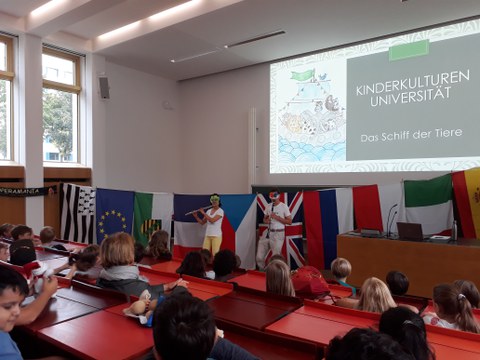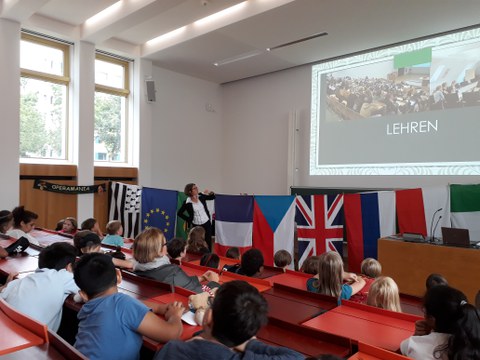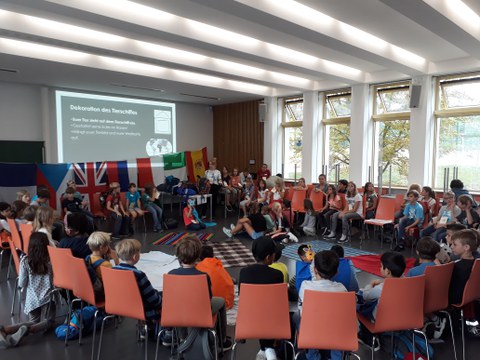1st Children's Cultures University on September 07, 2018

Musikalische Eröffnung der KinderKulturenUniversität durch Kiki und Kuku
Under the patronage of Prof. Dr. Roswitha Böhm, Chair of French Studies at TU Dresden, and in cooperation with Bildungsfunken. Verein für Demokratie durch Bildung e. V., the CFF Centrum Frankreich | Frankophonie and the Center for Teacher Education and Educational Research (ZLSB) at TU Dresden, the 1st Dresden Children's Cultures University took place on September 7, 2018 as an inclusive educational experience for pupils in grades 4 and 5 at TU Dresden.
On this day, 75 pupils from two elementary school and a grammar school got to know the TUD Dresden University of Technology as a new place in their home city and the importance of curiosity and asking questions as tasks of scientists. They themselves became researchers by investigating why animal sounds are reproduced differently in different languages.

Kindervorlesung von Prof. Dr. Roswitha Böhm
After a short lecture by Prof. Dr. Roswitha Böhm on the location of the university, the tasks of scientists and the formats in which students learn here, the research work on animal sounds took place in heterogeneous learning groups.
Initially, videos created by the preparatory team in collaboration with native speakers were shown in which speakers of Arabic, Chinese, Czech, Polish, Russian, Greek, French, Spanish and Japanese imitated animal sounds. The pupils analyzed similarities and differences and supplemented individual languages by using their own multilingualism. By communicating with each other in an animal language of their own devising, they were sensitized to communication in the subsequent work process.

Gemeinsamer Abschluss auf dem ‚Schiff der Tiere‘
Starting with tasks on animals that were particularly interesting for 4th and 5th graders and related to their everyday lives, the pupils answered various questions in a subject-linking learning setting designed as station work, solved them and formulated numerous others themselves. Among other things, they worked out biological characteristics and features of different animal species in a quiz, got to know different writing systems with the written reproduction of animal sounds and located the animal sounds on the world map with the help of atlases and globes. In a joint artistic final project, they presented their 'group animal' and introduced it to the whole group. The KinderKulturenUniversität concluded with a simulated meeting of all the animals and pupils on the 'Ship of Animals' and ended with a picnic with music and dancing.
to the cooperation partners:
